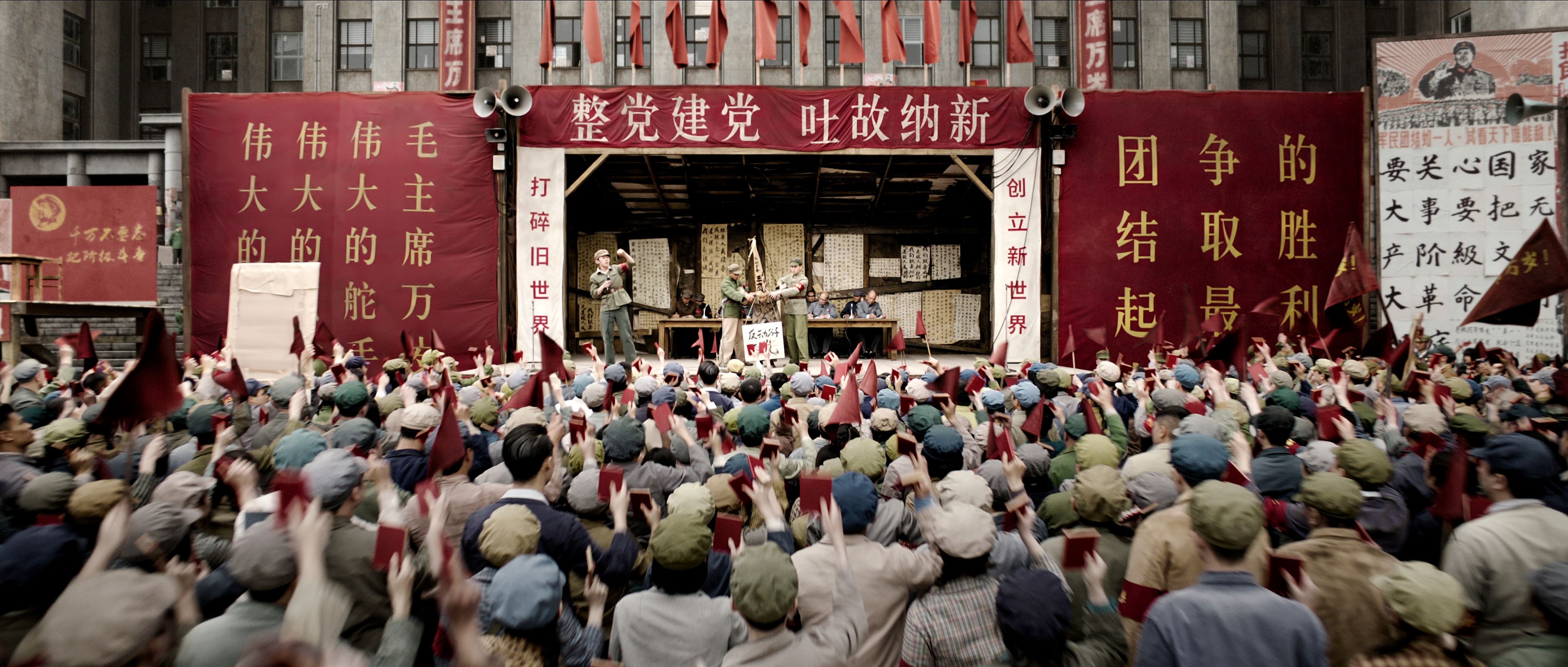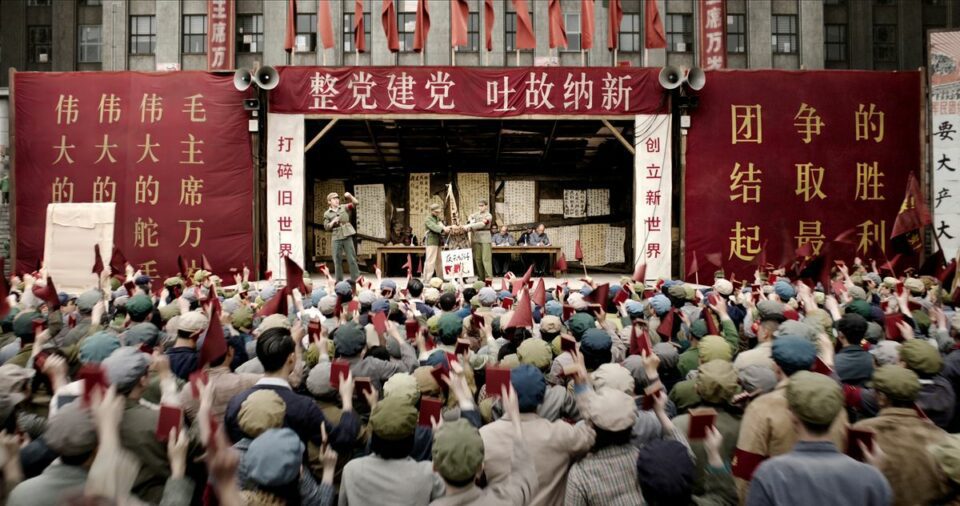
Netflix’s adaptation of The Three-Body Problem alternates between two settings. It begins, like Cixin Liu’s original trilogy, in 1960s China, a country in the death throes of Maoist totalitarianism. Episode one opens with a denunciation ceremony that ends in the grisly death of a physicist at the hands of his students; watching from the audience, his daughter, a young astrophysicist named Ye Wenjie, learns that it was her mother who turned him in. Taken as a political prisoner, twice betrayed by men close to her, Wenjie is eventually recruited to work on a secret national-defense project, during which she becomes the first person on Earth to receive an intergalactic signal from an alien civilization. Finding no remorse among her victimizers and faced with a national and personal wronging that does not seem rectifiable by any means, she draws the ultimate conclusion: Humans cannot be responsible for their own salvation, and something must intervene from the outside. Understanding immediately that answering the signal would disclose Earth’s coordinates to a hostile enemy, Wenjie responds — laying the groundwork for an invasion that won’t take place until many years into the future.
This historical period isrendered in an astonishingly realistic way in this new adaptation. The Cultural Revolution denunciation ceremony itself has never been portrayed with such length or detail in cinematic or TV history, not even in the mainland (the Chinese Tencent adaptation, released last year, skipped the scene entirely; we’re only told by present-day characters that the betrayal and murder occurred). These episodes are an achievement in cross-cultural depiction, in their historically and physiognomically accurate gestures and looks, and in the ugly feelings and acts unique to an ideological landscape in which wives turn on husbands and children on their parents and teachers. Here, a formidable mind is forced to react to a world that forces its inhabitants to constantly out-think everyone else’s despicable moves, to game out who you can take advantage of before they take advantage of you.The daughter of a class enemy, vulnerable to the whims of others and with little room to maneuver, Wenjie doesn’t cease in her efforts to deduce the intentions of those around her and to come up with solutions to unsolvable predicaments.
When the series jumps to the contemporary present, however, the commitment to portraying hardships and impossible predicaments all but disappears. These episodes follow a group of physicists in present day London, all students of Ye Wenjie, who learn that one of their colleagues has committed suicide. In the course of uncovering the mystery of her death, the physicists find out the truth about their teacher’s wager. They learn that not only are the aliens on their way, but that they are being assisted by an atavistic intelligence group on Earth. But unlike the historical episodes, in which characters act pragmatically and decisively, the contemporary protagonists often find themselves conflicted on how to deal with the aliens’ impending arrival. They fret over whether the solutions and alliances proposed are compromising their ideals. Often, the series seems insufficiently afraid of its own premise, encouraging its characters to get distracted by banal dramas and simple moral quandaries. They are fitted with off-the-shelf traumatic backgrounds in an attempt to give them troubled lives and troubled inner states — parents swept away in a flood in China, immigration troubles at work, drug use and dissolution. The result is that the show’s contemporary present feels incommensurate to its past, unable to meet its gaze because it doesn’t know real sadness and fear.
There’s one obvious thing to blame for this dissonance. In adapting Liu’s trilogy for the screen, the producers — David Benioff and D.B. Weiss (Games of Thrones) and Alexander Woo (The Terror) — stayed faithful to the parts of the book that took place during the Cultural Revolution and put their own spin on its contemporary chapters, moving their setting from modern China to modern London and reassigning the storylines to characters of different races. Wang Miao, the nanotech developer, and Cheng Xin, the aeronautical engineer, have been combined into a young Mexican scientist-slash-entrepreneur named Augustina Salazar; Chang Weisi, a Chinese general, and Colonel Stanton, a U.S. officer, have been combined into a high-ranking British intelligence officer named Thomas Wade. But this fact of racial reassignment doesn’t explain to satisfaction why we find these characters so untrue to the original books. The setting of Liu’s trilogy, after all, expands the way globalization expands, moving from the isolated corners of Maoist tragedy to multinational organizations, from traumatized Chinese people to disillusioned foreigners.
Rather, the true diagnosis of the show’s problems have more to do with an omnipresent force animating the book: a ruthless form of logical thinking, expressed mainly as the drive to convey and glean the maximum amount of information from the minimum amount of data. This sensibility can be owed in part to the Chinese language and its extraordinary ability to be compressed — an attitude toward communication that was only supercharged by recent Chinese history, the 100-year span from Maoism to the modern surveillance state which intensified the everyday practice of speaking in code and deciphering the codes of others. What emerges from this history is the extreme form of logical reasoning that propelsLiu’s trilogy: the ability to arrive at the analytical conclusion quickly and act accordingly, as well as to communicate and infer a great deal from very little, without the option of assuming privacy or good faith. Benioff, Weiss, and Woo’s take on The Three-Body Problem suggests that while they accept Liu’s rules of reasoning and dutifully depict its origins, the showrunners seem unwilling to extend those rules into the present and to craft characters that bear their burdens.
In the original Three-Body Problem trilogy, Liu is writing out a viable solution for the Fermi Paradox, which asks: If the universe is filled with Earth-like planets and therefore likely teeming with life, why have we not heard anything? For some, the universe’s silence attests to the fact that, while all species need to expand to survive, no species, humans included, can cross the final threshold of interstellar expansion. Liu, however, has come up with a different answer. His solution comes from game theory and is modeled on the concept of the“sequential and incomplete information game”: If an alien species has not communicated with you, it’s because it is not in their interest to do so, as communication would involve disclosing their locational coordinates. Once they can communicate with you, it means that they are certainly ahead of you technologically, probably by an order of magnitude. Therefore, all communication is warfare, even if both parties mean well and intend peace, because there’s no way to verify the genuineness of good intentions and because all communication contains reliable information about respective capabilities and degree of technological advancement.The Three-Body trilogy concludes that, from the standpoint of game theory and physical reality, the best and safest thing to do when one civilization receives a message from a distant one is to mobilize to destroy it.This grim optimal strategy, which treats bad faith as the default position, is replicated in Ye Wenjie’s decision during the Cultural Revolution. By simply pressing the “receive” button — a move that conveyed not only Earth’s location, but also the level of technological difference between the two civilizations and the existence of intelligent defectors — she did all she needed to seethe alien takeover to the end.
This straight path, from the minimum amount of information to their final conclusion, also describes the way Liu’s contemporary characters deduce the aliens’ plans to invade Earth. Simply by playing a video game, they learn that the Trisolarans come from a world with three suns, whose movements can be modeled but never, according to the laws of physics, determined or predicted for certain. The inhabitants of this foreign planet can be boiled or frozen at a moment’s notice. Over eons of time, the scientists deduce, the residents of this planet have tried every tactic to survive, but are left with no choice than to take over someone else’s world and take steps to guarantee an unfair match when they arrive. To prepare for their invasion, the Tri-Solarans weaken Earthlings the way an intelligent and technologically advanced enemy would: they kill off the best and most threatening scientists by making their experiments go wildly awry; they spy on us and make us disbelieve what we see with our eyes.
After the nature of the crisis is established, Liu’s characters devote themselves to either figuring out the mechanism of a difficult problem or to doing something directly useful about it. These characters serve clear purposes, selected to help defend against the Trisolarans strictly for some specific capability: An applied-physics expert is asked to apply physics to kneecap the Trisolarans’ allies on Earth; a lazy mathematician with an intuition for geometry (and not much else) is brought in to try to solve the three-body problem. Each is highly practical, almost immediately falling in line on the mission; the unspoken assumption seems to be that no intelligent person selected to defend Earth wastes time deliberating over whether they’re doing the right thing.
Only one main character initially refuses to help Earth fight the aliens: Luo Ji, an astronomer-turned-sociologist selected to be a Wallfacer, one of four people tasked with designing, in secret, a defense plan. He fears for his personal safety (as in the Netflix show, he survives an assassination attempt) but gets onboard when his life is threatened by the U.N. These decisions, done out of self-interest or desperation, are true to his name: Luo Jí sounds very close to the Chinese term for logic. This practicality is mirrored in Liu’s writing itself: Once a fact has been established, whether it’s a piece of context or a decision to take action, it is never revisited. Both the Tencent and Netflix adaptations make much of the maddening effects of a countdown that appears on the retina of scientists who pose a threat to the Trisolarans, but in the book, the phenomenon is fully described — and accepted by the characters — in the span of a few pages.
In the contemporary episodes of the Netflix show, the scientists immediately regard the impending Trisolaran invasion as a no-brainer — save the humans, of course! But for the showrunners, it seems as though the direness of the crisis doesn’t suffice to give the story moral-emotional gravity, so, as though to make up for it, they resorted to an additive method.It’s not enough that the character Jin Cheng moves through the video game and realizes the unsolvable horror of the three-body problem, the show has also tacked on a side plot inside the video game in which she repeatedly fails to rescue a little girl, a half-hearted gesture to Jin’s own orphaning. With her resolve to find a solution to fight the Trisolarans, she is the character closest in disposition to her book analogs, but even she is given reasons to be less brutally rational in her decision-making. After devising a plan to send a brain to outer space to gather intelligence, she is distressed when the candidate ends up being her friend dying of terminal cancer, especially when she finds out that he loves her. Overcompensating and undercompensating at the same time, the show holds out the hope that countless smaller melodramas add up to one large one.
What happens as a result of all this extra-ness is a dampening of Liu’s best creations. Take, for example, the nanofiber slicer, a weapon composed of a single invisible filament that destroys the enemy’s headquarters by slicing it in half. In the book, the nanofiber slicer represents an ingenious extreme measure to an extreme problem. Deployed against an enemy that sees everything coming, the weapon is both undetectable and mathematically efficient, killing everything by simply cutting it in half. The ingenuity of this creation is dead on arrival in the show, which has pre-digested it as a necessary evil done by heroes who must afterward express stock emotional and moral duress. Salazar, the inventor of the nanofibers, throws up when she realizes that her invention was used to murder and carries on her consternations for the rest of the show, relenting only when she uses her technology to bring clean water to parts of Mexico. Her self-righteousness is barely contained: Nanofibers, she says, “can make life better for the people who need it most; it shouldn’t belong to anybody, it should belong to everybody.”
From the face of it, it appears that the Netflix show is far more interested in morality than the original trilogy. After all, the show’s characters appear to have a conscience — they experience conflict about hurting a few to help many — whileLiu’s characters appear flat and without interiority. This flaw, which readers often point out, can be partially explained by Liu’s own assessment of what he’s trying to do. “Never did it occur to me,” he once wrote of own contribution to science-fiction studies, “that I would ever be this closely associated with the world of literature, especially as I to this day feel no particular fondness for it.” Rather, he seems more interested in providing a solution to a mathematical problem in world-historical terms. But what if this undertaking itself is the moral act?
In this undertaking, morality cares more about efficacy (what to do and how to do it) than deliberation (should we do it and whose opinions should we take consideration?). In the book, doing the moral thing means finding the most efficient and intelligent path under impossible circumstances, and completing the job without getting lost in the weeds of their own feelings. The showrunners, on the other hand, believe that the way to make decision-making more morally serious is to make it more beleaguered, to code its characters as recognizable moral agents. As a result, their moral problems mainly take the form of banal trolley problems.
There are no scenes in the book commensurate with the show’s scenes of moral turmoil.Liu’s characters would not agonize like Salazar because morality has already occurred. It is located not in any individual character or deed but in the way the story is concocted, in its relentless commitment to how real problems actually unfold, step by step. Whether it’s a promising modern-day scientist who is already close to nihilism or a civilization light-years away that has tried every tactic to survive, the author is interested in the same question: What would be the appropriate sequence of events that had to have happened to drive them to total despair? How would it happen mechanically?
Many of the show’s shortcomings stem from lazy character development, but there are also structural realities that almost guarantee the adaptation’s failure. While Liu set The Three-Body Problem in modern times, his story retains a commitment to causality that can be found in older, more ancient forms of storytelling. Fairy tales, fables, epics — these are stories that contain a total world system that keeps track of what happened to who and why. Modern storytelling has different priorities: interiority, reflexivity, individuation, and so forth. There are benefits to these features, but literary theorists have already tallied the devastating losses; Roland Barthes, for example, said that details from modern narrative signify reality so well that you might lose track of causal reality, or “what really happened.” A similar structural problem flares up in migrating stories from non-liberal, non-democratic societies to liberal democratic ones. While Liu’s China does enjoy the accouterments of democratic liberalism, its logical core depends on a perspective far outside of it. That logic, which depends absolutely on a hierarchy of problems, deflates when applied to a society where all problems are treated as equally serious, and where every individual is automatically a protagonist with their own background trauma. This problem of translation gets a whole lot worse when dropped into the American entertainment industrial complex, in which decisions about representation and narrative are always beholden to imperatives of customization: appealing to different viewing demographics by representing romantic versions of themselves back to themselves.
All alien-contact stories are allegories of contact between two ways of doing things. And if the allegory of Liu’s trilogy is about communication as warfare, its dire and confusing stakes in times of real crisis, this allegory is displaced in the Netflix show by the communicative dilemmas that only happen when you have the luxury to not think in such drastic terms: Can people of different races come together in friendship and science? Can you tell the person you love that you love them in time? These are valid questions to ask, but in the context of the show, they become jarring and ridiculous in their adjacency to the bigger priority presented by the Trisolarans’ mission to usurp Earth. Without knowing it, the Netflix show confirms once again the pessimistic thesis of Liu’s trilogy: that for reasons as inexorable as natural laws, the passing of information between two worlds will happen, but with one side always a little less prepared.
By Nan Da , 2024-04-03 13:00:46
Source link


